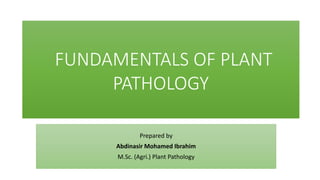
Lect. I - Introduction & history of plant pathology.pptx
- 1. FUNDAMENTALS OF PLANT PATHOLOGY Prepared by Abdinasir Mohamed Ibrahim M.Sc. (Agri.) Plant Pathology
- 2. Lecture I INTRODUCTION & HISTORY OF PLANT PATHOLOGY
- 3. Learning objectives In this presentation you will learn to: The word pathology Objectives of plant pathology Significant of plant diseases History of plant pathology
- 4. Introduction Plant pathology is the study of the plant diseases and disorders of plants. Plant diseases and disorders make the plant to suffer, either kill or reduce their ability to survive or reproduce.
- 5. Term The term ‘Pathology’ is derived from two Greek words ‘pathos’ and ‘logos’, ‘pathos’ means suffering and ‘logos’ means to study. Therefore pathology means “study of suffering”. Thus plant pathology or phytopathology (Gr. Phyton = plant) is a branch of biology that deals with the study of suffering plants.
- 6. Objectives Plant pathology has four major objectives I. To study diseases/disorders caused by biotic and abiotic agents II. To study mechanism of disease development III. To study the interaction between plant and the pathogen in relation to overall environment IV. To develop suitable management strategy to surmount the diseases and to reduce the loss
- 7. Significant of plant diseases Fossil evidence indicates that plants were affected by disease 250 million years ago. The plant disease have been associated with many important events in the history of mankind on the earth. Wheat smut has been recorded as early as 1900 BC which reduced the yields of the grains used for making bread.
- 8. Holy fire or St. Anthony’s fire After the decline of the Roman Empire, poor people relied on rye bread as their primary food source. People who ate the bread made from rye flour inadvertently ground with ergot suffered from gangrene due to severe constriction in blood vessel. Hands and feet literally fall of producing a disease namely ‘Holy fire or St. Antony’s fire’. St. Antony’s fire Ergot Gangrene feet
- 9. Late blight of potato A series of wet and cool condition in the 1840’s led to the outbreak of disease epidemic called ‘late blight of potato’ which completely destroyed crop and caused severe potato losses in Northern Europe; that resulted in the death of hundreds of thousands of people and emigration of more than one and half million people from Ireland to the United States. This disease outbreak caused the great ‘Irish famine’ during 1845 and 1846. Irish farmers Effect of Late blight of potato
- 10. Sri Lanka (Ceylon) Sri Lanka used to produce maximum coffee in the world. In 1867 coffee rust attacked the plantations in Sri Lanka and by 1893 the export of coffee from Sri Lanka had declined by 93 percent. Monoculture - coffee Coffee seeds
- 11. Cassava Mosaic disease Cassava Mosaic disease often results in 15 to 24% storage root yield losses storage root yield losses of cassava annually across Sub-Saharan Africa, which is equivalent to an annual loss of US 1.2 to 2.3 billion and this led to starvation death of nearly 3,000 people in Uganda during 1994. Storage effect In the field
- 12. History of Plant Pathology Ancient Era The ancient Romans created rust god ‘Robigus’, goddess ‘Robigo’ and sacrificed red colored animals such as dogs, foxes, and cows during the festival called Robigalia. People in those days thought that disease were produced spontaneously and and believed in theory of spontaneous generation. Robigalia festival
- 13. First microscope 1675 Dutch worker Anto Van Leeuwenhoek developed the first microscope. In 1683 he described bacteria seen with this microscope. Leeuwenhoek First microscope
- 14. Reproductive part of fungus In 1729 Antonio Micheli (Italian) was the first scientist who studied fungi and saw their spores under the microscope. He also proved that if these spores are placed on a piece of fruit they grow into a new thallus of the fungus. Micheli
- 15. Wheat Smut 1755 Mathieu Tillet (French) working with smutted wheat, showed that he could increase the number of wheat plants developing covered smut by dusting wheat kernels before planting with smut dust, i.e., with smut spores. He also noted that he could reduce the number of smutted wheat plants produced by treating the smut treated kernels with copper sulfate. He concluded that wheat smut is an infectious plant disease, he believed that it was a poisonous substance contained in the smut dust Tillet
- 16. Microorganism In 1807 Pierre Prevost (French) observed smut spores from untreated and treated wheat seed under the microscope and noticed that those from untreated seed germinated and grew whereas those from treated seed failed to germinate. He proved that disease are caused by microorganisms. Prevost Teliospore
- 17. Phytophthora infestans In 1853 Anton De Bary (Germany) confirmed the finding of Prevost. In 1861 he experimentally proved that the fungus Phytophthora infestans was the cause of late blight of potato. Anton De Bary Late blight of potato
- 18. Germ Theory In 1861 Louis Pasteur (French) proved that microorganisms were produced from pre- existing microorganisms and that most infectious diseases were caused by germs. He proved that food spoiled because of contamination by invisible bacteria, not because of spontaneous generation Louis Pasteur Food spoiled
- 19. Artificial nutrient In 1887 Richard Petri (Germany), who developed artificial nutrient media for culturing the microorganisms (Petri dishes) Richard Petri Petri dishes
- 20. Certain microorganism In 1887 Robert Koch (Germany), who established that for proving that a certain microorganism was the cause of a particular infectious disease, certain necessary steps (Koch’s postulates) must be carried out and certain conditions must be satisfied. Robert Koch
- 21. Questions What are the contributions of a) Leeuwenhoek b) Micheli c) Tillet d) Prevost e) De Bary f) Louis Pasteur
